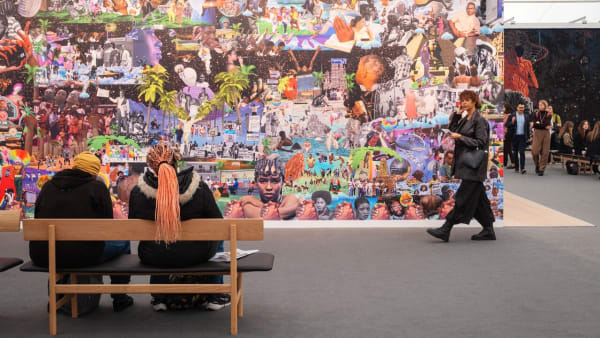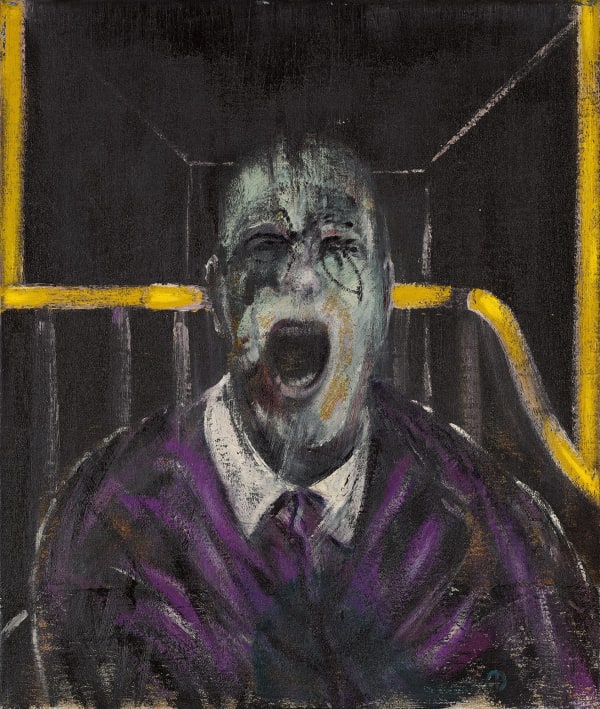-
Francis Bacon Prints For Sale.
Francis Bacon's art is a deep exploration of the human condition told through the revolutionary lens of a true genius. His distorted and contorted figures explore aspects religion, mythology & the deeply personal. Explore our latest Francis Bacon prints for sale at Guy Hepner, Bacon dealers since 2007.
Discover authentic Francis Bacon signed prints for sale below.
-
Works

Francis Bacon
Mirroir de la Tauromachie, 1990Lithograph on Arches Paper20 x 15 in each
50.8 x 38.1 cm eachEdition of 150Copyright The ArtistFrancis Bacon’s Miroir de la Tauromachie (1990) is a striking triptych lithograph that encapsulates the artist’s enduring fascination with violence, spectacle, and the raw physicality of the human—and animal—condition. Based...Francis Bacon’s Miroir de la Tauromachie (1990) is a striking triptych lithograph that encapsulates the artist’s enduring fascination with violence, spectacle, and the raw physicality of the human—and animal—condition. Based on the ritualistic intensity of the bullfight, a theme Bacon returned to throughout his career, this work transforms the traditional spectacle of tauromachia into a psychological and aesthetic battlefield. Executed in his final years, the triptych reveals Bacon’s undiminished ability to fuse brutality with beauty, abstraction with immediacy.
Printed in Paris by the renowned Mourlot studio and published by Galerie Lelong, Miroir de la Tauromachie was produced as a limited edition of 150 sets, each composed of three separate lithographic sheets printed on fine Arches paper. Each sheet is hand-signed in pencil by Bacon, underscoring the importance of the edition as a collector’s piece and a key work in the artist’s late printmaking oeuvre. Individually, the sheets measure 48 × 36 cm; when framed as a triptych, the total dimensions extend to 151 × 78 cm. The work is documented in major catalogue references, including Alexandre Tacou (no. 37) and Bruno Sabatier (nos. 29–30), confirming its significance within the canon of Bacon’s prints.
Visually, the composition is arresting. Across the three panels, Bacon conjures a chaotic ballet of muscular bulls and abstracted human forms, locked in ambiguous confrontation. Their twisted bodies—half-formed, half-dissolved—are rendered in deep blacks and earthy reds, placed against saturated fields of vivid orange, electric yellow, and moody blue. These backgrounds heighten the drama of the scene, creating a jarring contrast between the intensity of the forms and the purity of the surrounding colour. The result is a visual rhythm that suggests both motion and stasis, energy and obliteration.
As in many of Bacon’s works, the figures are at once figurative and abstract. Limbs, horns, and torsos blend into one another, often indistinguishable from the background, giving the impression of movement frozen at the edge of collapse. Bacon avoids literal representation, opting instead for psychological suggestion. The contorted forms evoke the violence and elegance of the bullfight, not as a literal event but as an existential metaphor—an arena where instincts, suffering, and survival intersect.
Bacon had long been drawn to the symbolic intensity of bullfighting. Its ritualistic choreography and stark confrontation between life and death mirrored many of the tensions that defined his practice. In Miroir de la Tauromachie, the matador and the bull become interchangeable—both participants in a violent dance, both condemned to suffer. The absence of clear narrative or identifiable figures deepens the sense of disorientation, echoing Bacon’s broader interest in distortion as a means of expressing psychological truth.
The title, which translates as “Mirror of the Bullfight,” invites reflection—both literal and metaphorical. Rather than presenting a documentary image, Bacon offers a mirror in which the viewer sees not the bullring but themselves. The arena becomes a symbolic stage for the drama of existence itself: power, pain, defiance, and demise, rendered through Bacon’s unique visual vocabulary.
The triptych format, one of Bacon’s most favored structures, further enhances the theatricality and narrative fragmentation of the piece. Each panel can be viewed as a scene in a tragic play or a frame in an unfolding psychological sequence. Yet there is no linear story, no resolution—only a confrontation with primal forces rendered in paint and paper.
Ultimately, Miroir de la Tauromachie is a masterful example of Bacon’s ability to compress the most extreme aspects of human and animal experience into a unified, dynamic visual statement. At once elegant and grotesque, formal and chaotic, it serves as both a late-career triumph and a summation of the artist’s thematic obsessions. Through distorted anatomy, vibrant colour fields, and a charged sense of space, Bacon renders tauromachia not as cultural tradition, but as existential spectacle—an image of life suspended on the edge of annihilation.
For more information on Francis Bacon’s Miroir de la Tauromachie or to buy Francis Bacon’s Miroir de la Tauromachie contact our galleries using the form below.Overview"The job of the artist is always to deepen the mystery".
Francis Bacon is one of the most important artists of the 20th century and post-war movements. Arguably one of the finest and most celebrated artists of his generation, Bacon holds a pivotal role in contemporary art through his revolutionary approach to his craft. One of the great explorers of the human condition Francis Bacon and his art, touch on fateful mix of mythology, religion, love and death, and document our joys, sorrows and pains perhaps better than any other artist before or since.
The imagery of Bacon is one of pure expression rejecting the prevailing artistic style of abstraction of the era, in favor of a distinctive and disturbing realism and his distorted forms convey a sense of both beauty and despair. The dichotomy in Bacon’s prints and imagery can be seen through his raw use of violent, yet delicate colors as well as the marriage he makes between the figurative and abstract. It is this soft balance between the brutal and the subtle, the violent and the soft and happiness and anguish that make Francis Bacon’s art so important and collectible. A master of painting, and known for his large scale canvases, Bacon combines seemingly disparate tectures, colours and forms to ceate a whirlwind of emotion conveying and reaching the heart of his subjective matter. Equally so Franci Bacon's print output, often as apres, lithographs or signed prints, offer his most popular subjects including Pope Francis and his famous triptychs.
Whether new to collecting Francis Bacon prints or an experienced collector, Guy Hepner can help. Since 2007 we have assisted clients across the world to buy Francis Bacon prints in confidence. Whether iconic triptych, lithographs or apres, our experienced and knowledgeable team are on hand to help you achieve your collecting goals. From our New York and London galleries, offer a wide selection of authentic Francis Bacon prints for sale.
Contact info@guyhepner.com for our latest Francis Bacon prints for sale or to buy Francis Bacon original art. News
News-

London’s Frieze Week Record Breakers
A Guide to a Blockbuster Week of Sales October 20, 2025London’s marquee auction houses just concluded a blockbuster week of contemporary art sales, coinciding with the Frieze art fair. In a series of evening auctions...Read more -

A Collector’s Guide to Francis Bacon Prints
Why Collect Bacon March 14, 2025Francis Bacon remains one of the most powerful and influential artists of the 20th century. His raw, visceral works depicting the human form in distorted,...Read more




